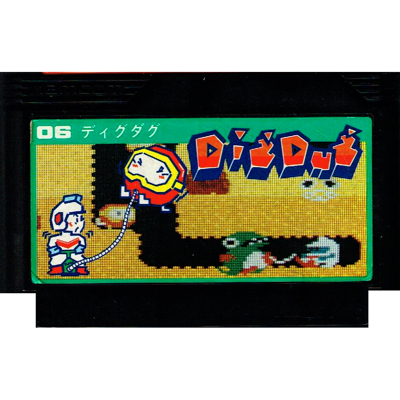DIG DUG FAMICOM
DIG DUG FAMICOM
Dig Dug (Digu Dagu) is an arcade game developed and published by Namco in Japan in 1982. It runs on Namco Galaga hardware, and was published outside Japan by Atari, Inc..
Atari also obtained the license for home versions of Dig Dug, and released it for the Atari 2600, Atari 5200, Atari 7800, ColecoVision, Intellivision, Apple II, Atari 8-bit family, VIC-20, Commodore 64, IBM PC, and TI-99/4A. Namco ported Dig Dug to the Famicom in 1985.
Gakken made a table top handheld game of Dig Dug in 1982. It was one of a series of 3 flip-top games with VFD screen and magnifying Fresnel lens.
The objective of Dig Dug is to eliminate underground-dwelling monsters, either by inflating them with an air pump until they explode or by dropping rocks on them. There are two kinds of enemies in the game: "Pookas" (a race of cute round red monsters, said to be modeled after tomatoes, that wear yellow goggles) and "Fygars" (a race of green dragons that can breathe fire when their wings flash).
The player's character is the eponymous Dig Dug, dressed in white and blue and able to dig tunnels through dirt. Dig Dug will be killed if he is caught by either a Pooka or a Fygar, burned by a Fygar's fire, or crushed by a rock.
It takes four (three in some versions) 'pumps' with the player's action button to inflate a monster until it pops. A partially inflated monster will deflate and recover after a few seconds, but half-inflating is a useful way to stun an enemy for a few moments, especially to make sure it remains in the path of a falling rock. The player can also pass through the enemy while it is deflating. In some versions, deflating is slow enough that the player can execute rapid, partial inflate actions and pop a monster much more quickly than just holding the 'pump' button down.
The monsters move horizontally on the surface and both horizontally and vertically through the tunnels in the dirt. While in the tunnels they can also turn into ghostly eyes which slows their movement but gives them the added advantage of diagonal travel through the solid dirt and rock. The last remaining enemy in each round will attempt to escape to the surface and off the top left side of the screen.
More points will be awarded for exploding an enemy further down in the dirt (the levels are color-coded). Additionally, Fygars are worth double points if exploded horizontally, since they can only breathe fire horizontally in the direction they are facing. Extra points are also awarded for dropping rocks on enemies in order to eliminate them rather than inflating them. If one enemy is killed by the rock, it is worth 1000 points. The next two add 1500 points each, and any after that add 2000. The act of mining is itself worth points—giving 10 points for each block mined—so some players will do as much of it as possible when the threat from the remaining monsters is minimal.
After the player drops two rocks, a bonus item appears at the center of the screen, awarding points if the player can collect it before it disappears. These items consist of various fruits and vegetables, as well as the flagship from the Namco game Galaxian, and appear even if either of the dropped rocks fails to crush any enemies. In the original arcade version, the most points attainable from a single bonus item is 8000 from the pineapple, which appears in round 18 and every round thereafter.
If the player should drop a rock on a foe at the same time he pumps it to death, a glitch will occur whereupon all enemies will promptly disappear, but the game will not progress and the player will be free to dig through all dirt. Attaining the next level of play will then remain impossible, but the glitch can be resolved by forcing a rock to drop.
The current round's number is represented by flowers in the top right of the screen, and each new round is noted at the beginning of each round. After every fourth round, the color of the dirt will alternate (as seen in this article's screenshot graphic).[clarification needed] In successive rounds more monsters appear on each screen, and they move more quickly. A round is completed successfully when the last monster escapes or is dispatched.
In the coin-operated version the game will end on round 256 (round 0), since the board is essentially an unplayable kill screen. When the round starts, a Pooka will be placed directly on top of where the player starts, and will kill Dig Dug instantly. There is no way to kill it, but the Atari version corrects this problem. No tunnels are drawn, save for the one that goes from the top-center to center. Strangely, a couple Pookas and Fygars also appear, but they don't have a tunnel to be placed in, so they are just overlaid onto the dirt.
ENDAST KASSETT

